Currency Notes
Paperback Builders
Finance & Development, June 2015, Vol. 52, No. 2
South Africa pays tribute to the country’s diversity in its latest currency design
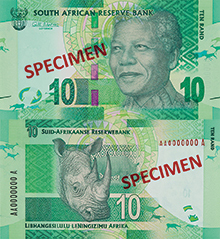
Countries with more than one official language often use public signage as affirmation of the status and usage of the national mother tongues. Thus road signs, official publications, national mottos or coats of arms, postage stamps, airliner decals, and other prominent platforms become vehicles for displaying and familiarizing two or three official languages.
Try 11.
That was the task facing newly democratic South Africa in 1994 when the self-styled “rainbow nation” succeeded the pariah apartheid state of the previous half century. Among the many novel features of the new nation was a sweeping expansion in the official language count. To foster a new sense of inclusive nationhood among the country’s diverse ethnicities, the two official languages that prevailed before 1994 became the 11 of the new South Africa.
We want to reach every South African through this communication campaign. It is our responsibility as the Reserve Bank to protect the credibility of the South African currency. This can only be done by making sure that the public know their money and its distinct features really well.
— Hlengani Mathebula, head of the South African Reserve Bank’s
Group Strategy and Communications Department
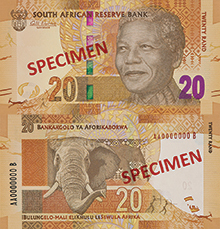
The English and Afrikaans of pre-1994 South Africa were supplemented after the democratic elections of that year by Ndebele, Northern Sotho, Sotho, Swazi, Tsonga, Tswana, Venda, Xhosa, and Zulu.
Nation builders looking for public platforms for 11 official languages can forget nearly all of the usual standbys available to two or three mother tongues. But one display medium still presents itself as uniquely qualified to promote 11 languages to a diverse nation: in daily use by nearly all citizens, easily recognized by color and design, supremely portable and storable, and a status symbol to boot: not the postage stamp—which is falling into digital desuetude—but the banknote.
Four functions
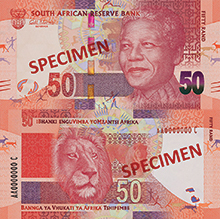
The latest reissue of South Africa’s five principal banknotes, officially launched in November 2012, serves four main functions, according to the South African Reserve Bank, which produced the notes.
● Commemorating former president Nelson Mandela, who died in 2013: Mandela’s appearance on the front of all five new notes is further formal recognition of his status as father of the new nation;
● Upgrading the security features of the national currency: Central banks worldwide have to stay one step ahead of the increasingly sophisticated scanners and printers available to counterfeiters;
● Promoting the “big five” big game species—rhinoceros, elephant, lion, buffalo, and leopard—in a country where wildlife conservation awareness is rising and safari parks are a major tourist draw; and
● Showcasing each of the country’s 11 official languages, to foster inclusion and cohesion among ethnicities that were once encouraged to develop separately.>
Another novel feature of the latest launch is the use of websites and social media to promote familiarity and acceptance of the new banknotes. South Africa is an emerging economy in a fast process of urbanization, but also with an informal sector that operates outside the formal structure of regulated and tax-paying commerce and employment. Information about sudden changes in currency design may therefore not easily reach such informal actors.
Cash economy
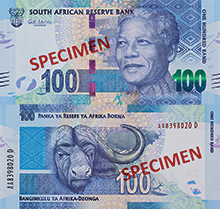
Because the informal sector is largely unbanked and therefore almost entirely cash based, wide recognition and acceptance of coins and banknotes are crucial to its effective operation. So the Reserve Bank announced it would sync the launch of the new banknotes with national road shows, taking samples of the new notes to “retail malls, transportation hubs, and pension pay points in urban and rural areas of the country’s nine provinces.”
Online and social media promotions detailed the appearance of the new cash and also urged a hands-on experience to its new users: “Members of the public are encouraged to continue to LOOK, FEEL and TILT the banknotes to check for a combination of security features,” the central bank’s website declaims.
Two by two
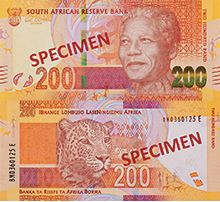
The 11 official languages are distributed among the five new banknotes by featuring English on the front of all the notes, and the other official languages in twos on the back of each denomination.
Information about the new banknotes has been published across a variety of communications platforms, including radio, television, billboards, banners, the Reserve Bank website, and print and online media also encompassing social media and mobile device sites. ■


